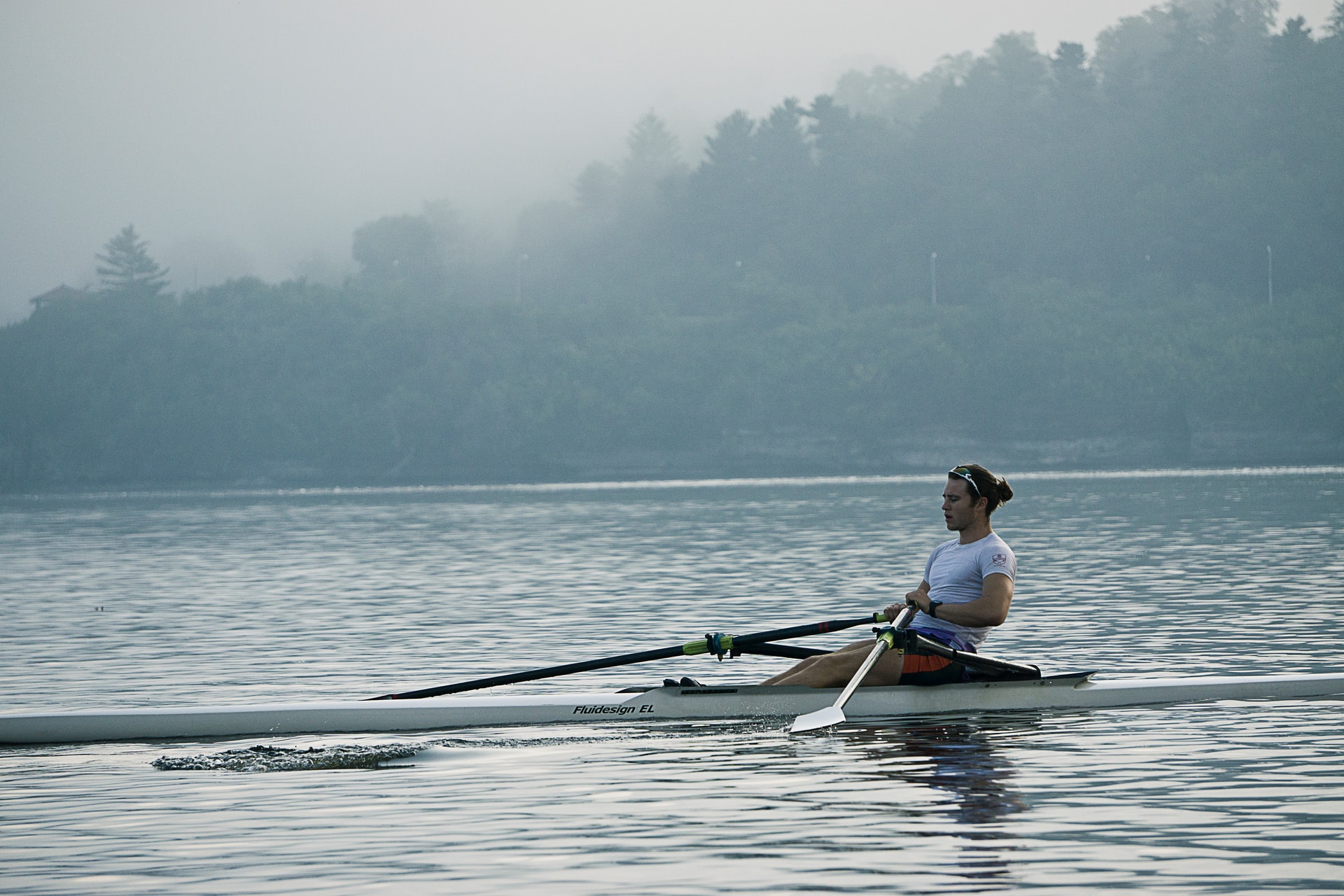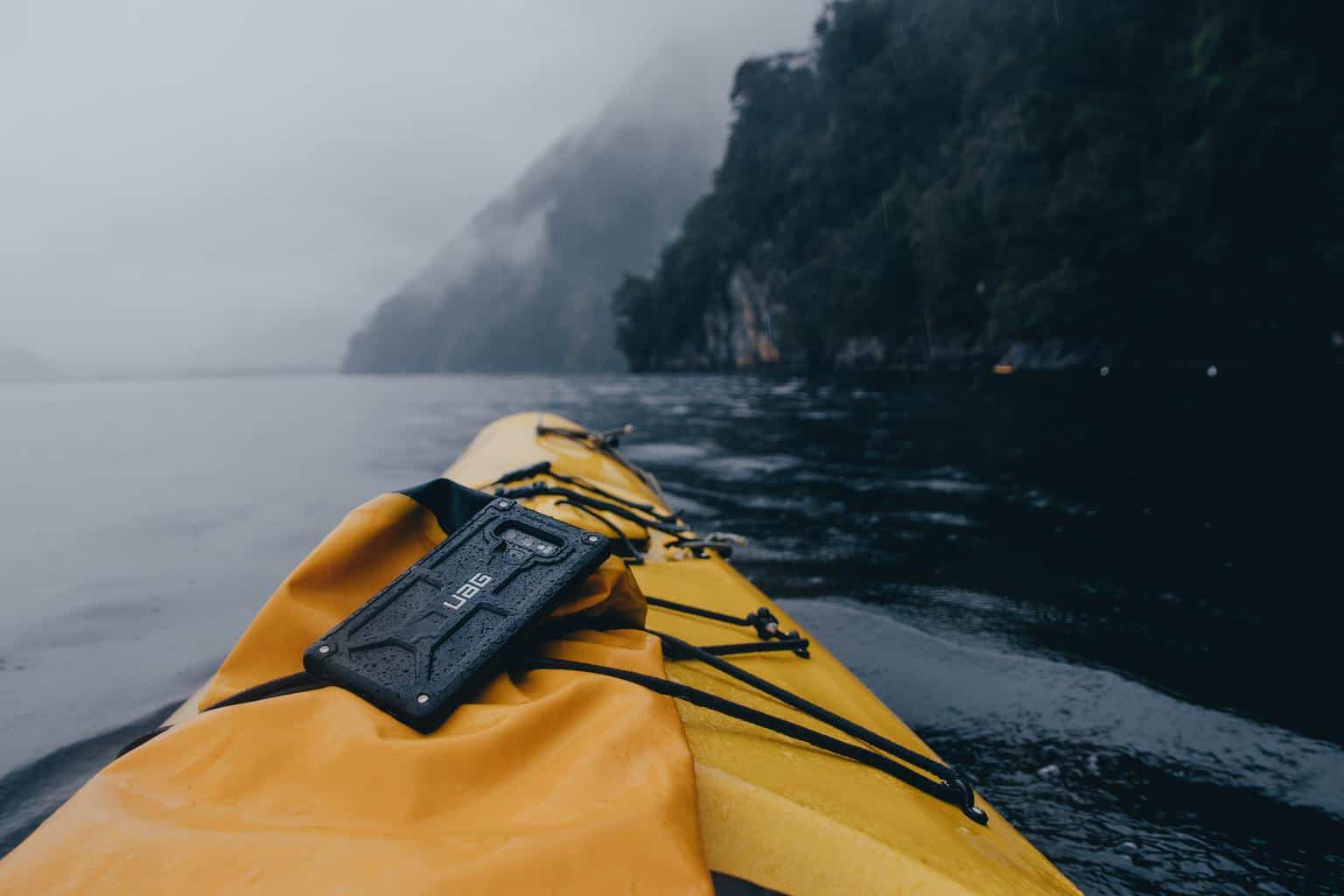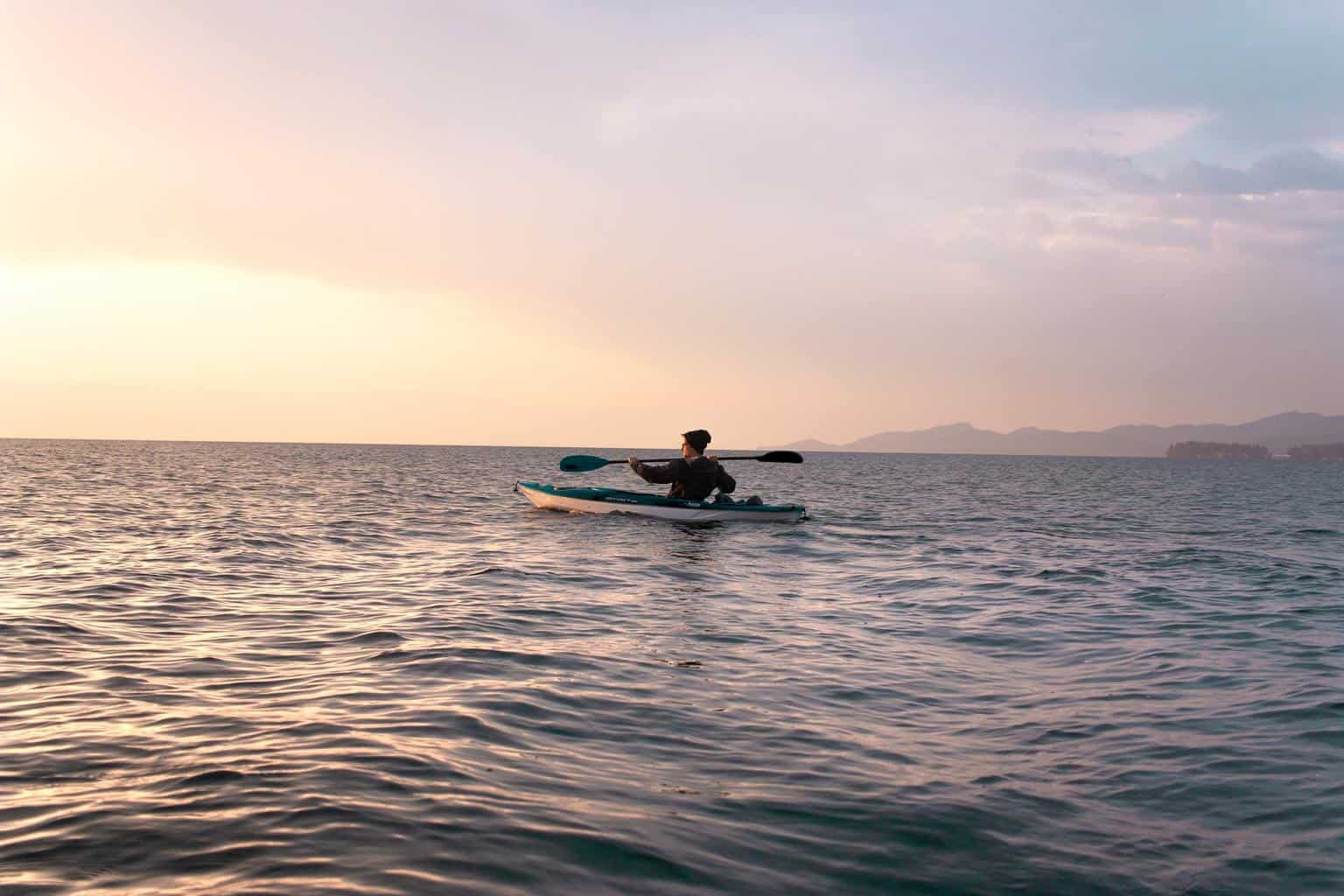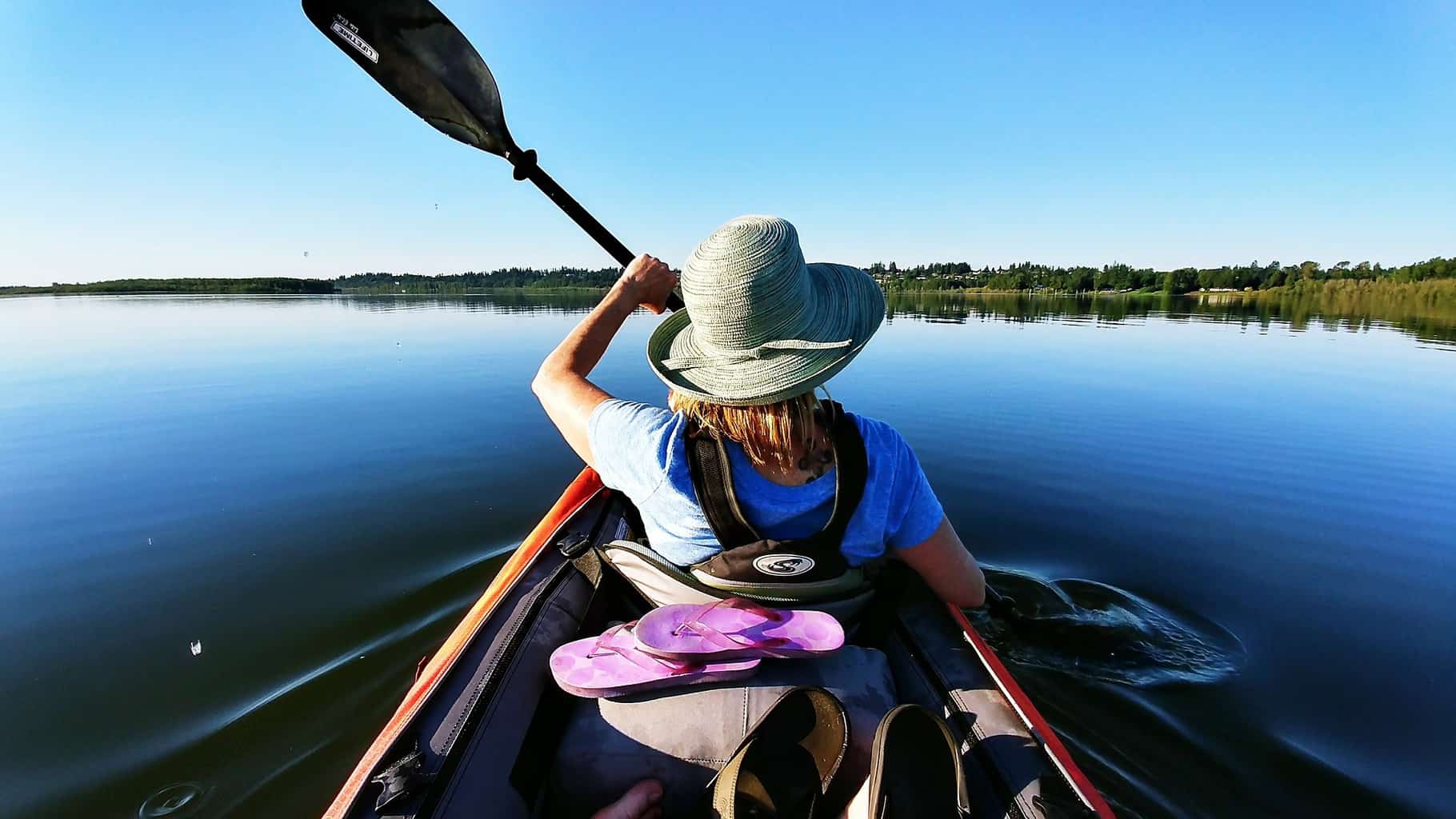Have you ever felt queasy when you were on a boating adventure?
If so, then seasickness while kayaking is a valid concern.
Not everyone gets sick when they go on a kayak, but some people do find the rocking and rolling sensation they experience on the water to be unsettling.
The good news is that understanding how and why seasickness happens can help you avoid this common ailment that can affect anyone who enjoys watersports.
- Do You Get Sick On a Kayak?
- Why Does Seasickness Happen?
- What Are the Symptoms of Being Seasick?
- What If I’m Prone to Seasickness?
- Can You Prevent Getting Seasick While Kayaking?
- Is Seasickness On a Kayak Dangerous?
- What Do You Do If You Get Seasick?
- How Do You Help a Seasick Kayaker?
- Conclusion
- You Might Also Like…
Disclosure: this post contains affiliate links (clearly marked with ), which means we may earn a commission if you buy something through them, at no additional cost to you.
Do You Get Sick On a Kayak?
Motion sickness can occur on just about any form of transportation, and seasickness is just another term for this ailment when it occurs on the water.
Most people associate seasickness with deep-sea adventures where big waves can rock a boat wildly from side to side.
While it is true that you are more likely to get sick on a large watercraft that is being bounced around, you do need to be aware that you can absolutely get sick on a kayak.
Why Does Seasickness Happen?
Seasickness may seem like it begins in the stomach, but it actually has its origins in the inner ear.
Your body’s vestibular system is made up of several structures and fluid inside of your inner ear that helps you to sense motion and maintain your sense of equilibrium.
When you are on the water, there is a conflict between the motion that your ears sense and the visual input that you receive since your surroundings may seem relatively still.
Once your body picks up on this incongruence, it releases stress hormones that leave you feeling nauseous and dizzy.
What Are the Symptoms of Being Seasick?
Seasickness is most commonly associated with nausea and vomiting.
These two hallmark symptoms are what makes it so uncomfortable to experience being sick on the water.
In addition to queasiness, a person who is feeling seasick may exhibit the following symptoms:
- sweating
- feeling dizzy
- pale skin
- headache
- general weakness or fatigue
Some people feel these symptoms come on suddenly, while others may feel queasy for some time before they pass on to the vomiting stage.
Paying attention to how your body feels can help you take preventative action that can sometimes help you avoid getting so sick that you have to end the trip.
What If I’m Prone to Seasickness?
Certain people are more likely to get seasick while they are kayaking.
First-time kayakers who have very little experience on the water should always be warned about the potential for getting sick.
You are also more likely to get sick on your kayak if you’ve ever experienced seasickness on a different type of aquatic adventure.
If you have any children that are between the ages of two and 12 in your group, then appoint an adult to keep an eye on them for signs of seasickness. Children in this age range are more susceptible to having motion sickness.
Pregnant women and people who tend to have migraines are also at a higher risk of feeling sick as they paddle out on the water.
Can You Prevent Getting Seasick While Kayaking?
There are some things that you can do to prevent yourself from getting sick if you are worried about the effects of motion on your body.
1. Watch What You Eat
Obviously, heading out onto the water with an overstuffed belly could make you more likely to feel the effects of seasickness.
Eating too many acidic foods before your trip can also increase the amount of acids that build up in your stomach.
You can begin your efforts to prevent seasickness the night before your trip by avoiding foods that are spicy or irritating to your stomach in general.
Although you definitely want to avoid foods that could make you feel sick, you also don’t want to head out on the water with your stomach completely empty.
Try to eat a light breakfast or lunch that includes a protein and a carbohydrate such as oatmeal and almonds or peanut butter toast.
Experienced kayakers also know to bring snacks on their boats. On top of giving you an energy boost, eating a light snack can help to absorb acids in your stomach if you begin to feel queasy.
Granola bars or crackers are excellent options to nibble on if you notice the early effects of motion sickness on your body.
2. Stay Hydrated
Dealing with a hangover on your kayaking trip is no fun, and it increases your risk of feeling nauseous.
Avoid drinking alcohol the night before your adventure, and make sure to drink plenty of water.
Dehydration can quickly set in when you are paddling beneath the hot sun, so bring water on your trip.
Take small sips if you are prone to motion sickness since guzzling too much at one time can lead to too much fluid sloshing around in your tummy.
3. Try Natural Remedies
People with severe motion sickness can talk to their doctor about special medications that can help them feel well.
There are also several natural remedies that people have found to help out over the years.
Ginger is known for helping to reduce feelings of nausea. Consider bringing along some dried ginger or candies to enjoy during rockier parts of your trip.
Special wrist bands are available that apply pressure on specific parts of your wrist. This acupressure form of therapy works for some people who know that they tend to get motion sickness.
4. Look At the Horizon
Kayaks already give you an edge on avoiding motion sickness since they provide an open view of the area around the boat.
Many people who do get seasick find that expanding their viewpoint beyond the small area around their boat helps.
Try to keep your eyes focused on the scenery beyond your boat so that your visual input matches the motions detected by your vestibular system.
Keeping an eye on the horizon helps your body to realize that you are in continuous motion.
Is Seasickness On a Kayak Dangerous?
Most people find vomiting to be fairly uncomfortable, and it is possible that someone could get so sick that they are no longer able to control their boat.
Although it might feel embarrassing, you should always be prepared to let your group know if you need to head back to shore.
Trying to hide your nausea or dizziness can lead to potentially life-threatening situations on the water such as capsizes and even being unable to continue paddling your boat.
What Do You Do If You Get Seasick?
Mild seasickness might respond to self-care on your kayak. You can try sipping on water and taking a few deep breaths to see if the nausea eases up.
Splashing some cool water on your face can also help with feeling clammy or sweaty.
If you do feel like you are going to vomit, then avoid hanging your head over the water. This can throw you off balance and cause you to capsize.
Capsizing while you are in the midst of vomiting can leave you vulnerable to accidentally aspirating the water.
Instead, allow yourself to vomit on the spray skirt of your boat.
Although this might not be pleasant, it is safest to continue to stay as upright and in control of your boat as possible.
After you recover, you can easily rinse any vomit off of the spray skirt.
Getting sick on your boat also means that it is time to head back to shore where you can continue your recovery on dry land.
How Do You Help a Seasick Kayaker?
At times, you may discover that you have a seasick kayaker in your group.
If they are managing their symptoms well, then you can simply suggest heading back or offer to take a break to snack on a cracker.
Rescuing a kayaker who can no longer paddle on their own can be done by moving your kayak alongside theirs so that they can stabilize themselves by hanging onto the deck.
If it is just the two of you on the water, then you can use a contact tow to get them back to shore.
If possible, a rafted tow with a third kayaker is the safest way to get your team member safely to the shoreline.
Once you get them on dry land, observe them for signs of dehydration. Offer them water or a sports drink once they are done vomiting to help replenish their body’s fluids.
Conclusion
Fortunately, seasickness on kayaking trips is relatively rare, and most people already know if they are sensitive to certain types of motion.
As always, remember to be cautious if you or anyone in your group is prone to seasickness.
Often, all it takes is slowing down and looking at the horizon to get back to paddling again.
Some kayakers also find that gaining more experience on the water helps them to overcome their tendency to get sick.
Planning shorter adventures on calmer bodies of water can help you develop your sea legs and feel more comfortable when you kayak in the future.
You Might Also Like…
-

Kayaking Vs. Rowing: What’s the Difference? (8 Key Differences)
-

When Is It Too Windy for Kayaking? (Crucial Facts You Should Know)
-

When to Go Kayaking? (What Every Kayaker Should Know)
-

Will I Get Wet Kayaking? (Common Reasons & How to Stay Dry)
-

Should I Bring My Phone Kayaking? (7 Good Reasons)
-

What Shoes to Wear Kayaking? (+ the Best Shoes for Your Needs)
-

Can Kayaking Cause Chest Pain? (What Every Kayaker Should Know)
-

Can I Go Kayaking With a New Tattoo? (Facts You Should Know)
-

Can You Go Kayaking On Your Period? (+Practical Tips)
-

Can Kayaking Cause Hemorrhoids? (What Every Kayaker Should Know)
-

Can Kayaking Cause Tennis Elbow? (+8 Simple Tips to Avoid It)
-

Can Kayaking Cause Sciatica? (+7 Tips to Avoid It)












